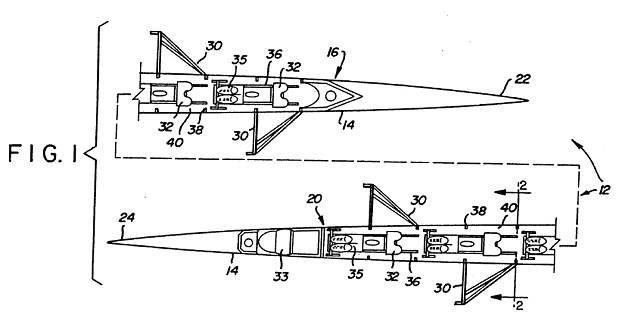As a sport dating back to the early 18th century, rowing has no doubt experienced a rich and deep history of innovation. Advancements in materials, construction methods, and technique have each driven the sport toward ever-higher records of speed and competition. The following analysis takes a brief look into some of the inventions that have helped shape and support the age-old sport.
US Patent 8,192,242 (“Luecker”) provides a system for determining the magnitude of force applied to an oar by a rower. Leucker utilizes a strain gauge placed along the shaft of the oar near the collar. A power source placed internally within the shaft is connected to the strain gauge. An LED display positioned flush with the oar shaft and positioned between the oar grips transmits information regarding the rower’s instant performance. The force sensing oar is shown below.

US Patent 5,279,239 (“Vespoli”) provides an initial design for a four-man racing shell, developed for use with heavy or lightweight crews. The shell is designed with canoe-type bow and stern sections, and four seats with corresponding foot-wells, sliding track, and optional sweep or sculling type adjustable riggers. The hull is designed of an inner and outer layer of carbon-fiber skin, surrounding a honey-comb or similar core material. This combination spans the length of the shell, providing a lightweight rigidity necessary for competitive performance. Deck supports and shoulders are also disposed along the length of the hull to provide additional stability. The four man racing shell can be seen below.

US Patent 8,341,764 (“Wilson”) describes a calf protector for use by rowers. While rowing, it is commonplace for a rowers’ calves to come into contact with the end of the seat rails upon which the seats roll from bow to stern. The friction between the seat rails and the calf will often result in bruising and damaged skin, which is often at risk for getting infected. The calf protector as detailed by Wilson provides an elongated strip, preferably made from neoprene or a similar synthetic and hook fasteners, such as Velcro, on either end to allow for the engagement of loops in the fabric on either end. The elongated strip has a wide middle section and is flanked on either side by narrow first and second sections, which contain the hooking mechanism. The calf protector is placed around the calves of the rower, and secured using the hook fasteners to prevent and absorb abrasion between the calf and the seat rails of the boat. The calf protector can be seen below.

US Patent 8,622,876 (“Kelliher”) describes a rowing simulator with a central shell structure, two resistance systems, and two oar guides/water tables. The rowing simulator permits at least two rowers to practice in unison, simulating rowing on the water, whereby they are positioned fore/aft of each other, and one is provided with a port oar assembly and the other with a starboard oar assembly. The seats can optionally be tied together to impose the same fore and aft movements on both rowers, a technique to force rowers to work in unison with one another. The resistance systems perform similarly to ergometers that are commonly used by rowers. The oar guide shape corresponds to the geometric arc of the oar guide followers. The tip of the oar guide is connected to the resistance system to both simulate the ideal height of power application, as well as the resistance of water. The shell structure provides the foundation for the seats, foot-wells, and seat rails that the rowers slide along. As a result of this setup, a resistance system and oar guide are positioned on both the port and starboard sides of the shell structure to simulate a sweep boat. The rowing simulator can alternately be built for a sculling style setup, whereby resistance machines are placed on either side of a single rower, simulating a sculling type boat. The rowing simulator is pictured below.

US Patent 6,881,112 (“Kunz”) discloses a rowing style and technique as an alternative to the traditional unison rowing commonly used competitive rowing today. Kunz describes a method for phase shift rowing, where equal numbers of rowers are divided in groups within the boat, whereby only the groups perform in unison. Phase shift rowing provides improvements in in power output and supports a higher average velocity for a given input force. The separate groups of out-of-phase rowing requires a spacing close to twice the boat spacing on a unison boat between separate phase groups. The phase shift style of rowing allows for two drive impulses in the time generally required for a single drive impulse in a standard rowing shell and technique. The phase shift style rowing can be seen below.

Rowing equipment and technique is constantly evolving to further advance the sport, the competition, and capabilities of the athletes. National and international brands in the rowing industry, such as Vespoli, Hudson, and Empacher are continually developing and innovating the equipment that rowers use to compete, while coaches and athletes alike are evolving the technique side of the sport, to further develop the speed, strength, and technique required to win and set new records. These patents have provided a glimpse into the world of rowing and the never-ending innovation that is occurring throughout the sport.
If you have any questions regarding: changing inventorship, responding to patent office actions, prosecuting your patent application, conducting interviews with patent examiners, branding, trademarks, patent planning or other intellectual property matters, please contact Garcia-Zamor Intellectual Property Law, LLC







